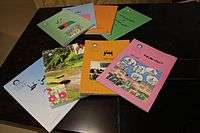Southern Pashto
Kandahārī Pashtō (Pashto: کندهارۍ پښتو), also known as Southern Pashto, Western Pashto, or Southwestern Pashto,[1] is a Pashto dialect, spoken in southern and western Afghanistan, including the city of Kandahar. It is similar with Quetta (Kakar) and Khattak dialects (95–100% similarities in vocabulary, and 80% with Yusufzai dialect). It is one of the most archaic and most prestigious varieties of Pashto.
 |
| Part of a series on |
| Pashto language |
|---|
|
| Writing systems |
| Dialects |
|
| Language regulation |
|
Academy of Sciences of Afghanistan Pashto Academy |
| Native to |
Kandahari Pashto is spoken in Kandahar, Helmand, Ghazni, most of Urozgan, Farah, and Nimruz, southeastern Ghor, the districts of Murghab, Ghormach, Muqur, and Jawand in Badghis, and parts of Zabul, Paktika, and Herat provinces of Afghanistan. It is also spoken in parts of the provinces of Razavi Khorasan and South Khorasan in Iran, where they numbered roughly 120,000 (in 1993).[2] Kandahari Pashto is almost same as the southeastern Pashto dialect, spoken in northern Balochistan including Quetta city, except for few phonetic differences.
The Kandahari dialect retains archaic retroflex sibilants, /ʂ/ and /ʐ/ (in other dialects, they have shifted to ʃ/x and ʒ/g). In the Quetta and Kakar dialects they change to ʃ and ʒ. Kandahari also has the affricates /t͡s/ and /d͡z/.
| Dialect[3] | ښ | ږ | څ | ځ | ژ | ā |
|---|---|---|---|---|---|---|
| Kandahar | [ʂ] | [ʐ] | [t͡s] | [d͡z] | [ʒ] | [ɑ] |
| Khattak | [ʃ] | [ʒ] | [t͡s] | [z] | [ʒ] | [ɔ] |
| Quetta | [ʃ] | [ʒ] | [t͡s] | [d͡z] | [ʒ, z] | [ɑ] |
| Peshawar | [x] | [ɡ] | [s] | [z] | [d͡ʒ] | [ɑ] |
Pronouns are also archaic. It is differences in 'he' and 'she' pronouns. In all 3rd-person pronouns 'h' is articulated.
| Personal pronoun[3] | Kandahar | Quetta | Peshawar | Meaning |
|---|---|---|---|---|
| زه | zə | zə | zə | I |
| ته | tə, less often təi | tə, less often təi | tə | you (singular) |
| هغه | hağə | ağə | əğə | he |
| هغه | hağe | ağə | əğə | she |
| موږ/مونږ | mʊž̥ | mʊž/məž | muŋ/muŋg | we |
| تاسو/تاسې | tāse/tāsī | tāse/tāsī | tāso | you (plural) |
| هغوی | hağwi/hağūi | ağwi/ağūi | ağʷi/ağʷəi | they |
The Pashto spoken in Kandahar has adding to that more unique features. Such as the Letter ه is pronounced as -eh not as -ah like in the North. Further more there is a distinction between /w/, /v/ and /u/ in speech yet it is all written with the letter و. Unlike other Dialects in Pashto the /v/ and /w/ sounds are separate while in the other Dialects they morphed to /w/ or /v/.
References
- Prods Oktor Skjærvø, P.O. 1989. Pashto. In "Compendium Linguarum Iranicarum", R. Schmitt (ed.), 384-410.
- https://www.ethnologue.com/country/ir/languages
- Hallberg, Daniel G. 1992. Pashto, Waneci, Ormuri. Sociolinguistic Survey of Northern Pakistan, 4.